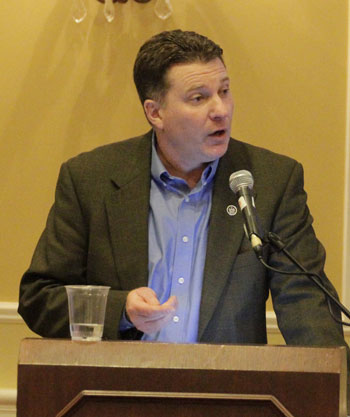TURNING A PROFIT,
continued from Homepage

Department of Marine Resources Commissioner Patrick Keliher speaks at the Maine Lobstermen’s Association’s annual meeting, at last month’s Maine Fishermen’s Forum. Laurie Schreiber Photo
Maine lobster landings went “through the roof” at 123 million pounds in 2012, an increase of 18 million pounds over 2011. But the harvest’s value declined by $3.7 million from 2011.
Comparing today’s landings figures with the industry’s historic average of 25 million pounds is considered “basically useless,” McCarron said.
“It doesn’t inform our future because things are so different,” she said.
Canada is also harvesting a lot of lobster. Combined United States and Canada landings in 2012 were more than 250 million pounds.
“It’s not just us,” she said. “We’re in a global market and our neighbors are landing more lobster than we are. Of total North American lobster, Maine is only 40 percent of that product. So as much as we’re struggling to get a good price, we’re just a piece of the overall picture.”
The picture proved especially challenging when June 2012 rolled around, a month during which Maine landings doubled.
“Our dealers and supply chains had to deal with twice as many lobsters in June,” McCarron said. “It’s just difficult to move five million extra pounds of lobsters.”
July 2012 was the industry’s second-highest landings month ever, with 25 million pounds of shedders. August 2012 was the third-highest month ever for a month landed – up in the 25 million pound range, mostly shedders. Landings were lower for the rest of the year, but remained steady.
“So not only were we shocking our market – who are our customers when we’re putting all this extra product out? – but Canada was doing the same thing,” McCarron said. “And we know the implications were pretty severe for you all as harvesters.”
The situation was not equal throughout the state. Zones A, D, and C land the lion’s share. Zone B comes in strong, Zone F slightly under, while Zone E is slow but steady.
In general, landings in Hancock County, from Mount Desert Island to Stonington, have doubled in the last three years. The harvest is almost 90 percent shedders for five months out of the year. Only four months of the year – February through May – see less than 50 percent shedders.
Harvesters need to be aware of the type of lobster they’re putting into the supply chain, and to have realistic expectations of what they’re going to do with – and earn from – the product, McCarron said.
The industry is also dealing with warming ocean temperatures, she pointed out.
One of the things that harvesters have control over, she said, is the quality of product they’re landing.

Folks lean in to hear Governor Paul LePage express his commitment to boosting the lobster industry, at the Maine Lobstermen’s Association’s annual meeting last month. Laurie Schreiber Photo
“What can we do responsibly, as an industry, to get the best thing to the dock, to give ourselves the best chance to get paid decently?” she said. “We look at things like yield. I hear the baloney comments: ‘Lobster is cheaper than baloney.’ It’s not. We are nowhere near baloney. We are a high-premium product.”
The industry should also think beyond the live market, she said. “This is the 21st century and we have to diversify what we’re doing with lobster,” she said.
The industry, she said, can also look at ways to minimize “shrinkage” – a euphemism for dead lobsters.
One dead lobster per crate, for 50 crates, costs a dealer $225 at current prices, she said.
“If it goes up to just under two dead lobsters in a crate, it’s not inconceivable that dealer is losing $405,” she said. “I think our board collectively heard the sucking noise of money leaving the industry. And this is something we can work on. We can minimize deads, we can minimize weaks, we can minimize damaged lobsters. We cannot land lobsters that can’t hold a band.”
If a dealer loses money, it ultimately comes out of the paycheck that they hand to harvesters, she said.
“We’ve never talked about this as an industry, but the better quality the lobster, the more opportunity it has to be sold,” she said. “That doesn’t mean it’s going to get a better price. But an undamaged, two-claw lobster could be processed, it could be sold locally in the live market, it could travel. It has options. And that will help you get a better price. A damaged lobster is going on a truck, and if that’s what you’re landing, it minimizes your earnings.”
McCarron said the board’s recommendations to harvesters include simple quality-control steps such as not throwing lobsters, and keeping them cool and aerated.
The board is also looking at long-term plans that include building demand nationally and globally. To that end, the state legislature is currently considering a marketing bill that would create a new marketing entity, funded by increased license surcharges and tasked to expand the market.
Governor Paul LePage told the gathering that his office was ready to work with the industry. “We want to help to make your industry more prosperous,” LePage said.
LePage said his administration is working toward branding Maine not only as a top-quality place but for its premium products. “We have high quality, high visibility around the world,” LePage said. “We just need to get our products in the right hands. What we had last year with pricing is something we have to avoid in the future. One of the things we’re going to work on in our office is to make sure the Maine brand is ‘the’ brand. I was in Florida last year with my wife, and I saw this big advertisement for Maine lobster. So I went in. I was all excited I was going to have Maine lobster – until I started quizzing the owner and found out it came from Massachusetts. But nobody knows Massachusetts lobster, so they call it Maine lobster. So it’s my job to make sure that stops, that when you hear ‘Maine lobster,’ it is Maine lobster. And that will help the price.”
McCarron noted that a recent, “tremendous explosion” of processing capacity in Maine is also expected to help the profit line. “People are finally making investments, opening up facilities, bringing a tremendous amount of infrastructure to the state,” she said. “Not all big players, but it’s tremendous news in terms of getting the word out that we want this. So I do think things have changed significantly.”
